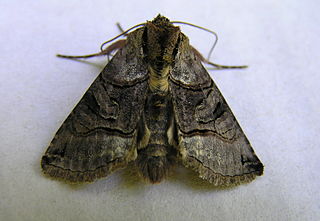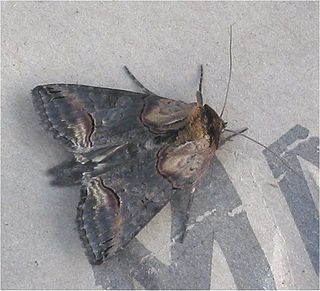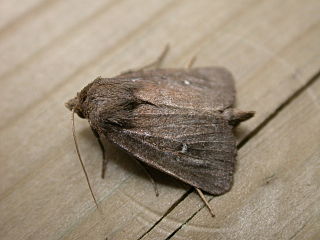
The Noctuidae, commonly known as owlet moths, cutworms or armyworms, are a family of moths. They are considered the most controversial family in the superfamily Noctuoidea because many of the clades are constantly changing, along with the other families of the Noctuoidea. It was considered the largest family in Lepidoptera for a long time, but after regrouping Lymantriinae, Catocalinae and Calpinae within the family Erebidae, the latter holds this title now. Currently, Noctuidae is the second largest family in Noctuoidea, with about 1,089 genera and 11,772 species. This classification is still contingent, as more changes continue to appear between Noctuidae and Erebidae.

The Abrostolini are a small tribe of moths in the Plusiinae subfamily, consisting of the genera Abrostola and Mouralia.

Abrostola tripartita is a moth of the family Noctuidae. It is found throughout much of the Palearctic realm including all Europe, Russia, Siberia Amur, Kyrgyzstan, and Kazakhstan.

Abrostola triplasia is a moth of the family Noctuidae. It is found across the entire Palearctic realm. Subarctic territories with an average temperature of below 6 °C are an exception. In the warmest and driest regions of the Mediterranean, the Middle East, and the mountains in West and Central Asia, the species occurs only scattered or is entirely lacking.

Abrostola is a genus of moths of the family Noctuidae.

Diphtherinae is a monotypic subfamily of moths in the family Nolidae erected by Michael Fibiger and J. Donald Lafontaine in 2005. Its only genus, Diphthera, was erected by Jacob Hübner in 1809. The genus was moved from Noctuidae in 2013 after the phylogenetic analysis of Reza Zahiri et al. (2013).

Simyra is a genus of moths of the family Noctuidae. The genus was described by Ochsenheimer in 1816.
Abrostola anophioides is a moth of the family Noctuidae first described by Frederic Moore in 1882. It is found in South-east Asia, including Darjeeling and Taiwan.
Abrostola brevipennis is a moth of the family Noctuidae. It is found from Kenya to South Africa.
Abrostola canariensis is a moth of the family Noctuidae. It is endemic to the Canary Islands.
Abrostola violacea is a moth of the family Noctuidae. It is found in Africa. The type location is the Ngorongoro Crater.

Abrostola urentis, the spectacled nettle moth or variegated brindle, is a moth of the family Noctuidae. The species was first described by Achille Guenée in 1852. It is found in North America from Nova Scotia west across Canada to Vancouver Island, south to North Carolina, Missouri, Texas, Colorado and Oregon.
Exophyla rectangularis is a moth of the family Noctuidae first described by Carl Geyer in 1828. It is found in Ukraine, Romania, Bulgaria, Albania, Greece, Montenegro, Croatia, northern Italy, Mediterranean Turkey, Lebanon, Israel and Turkmenistan.
Dysgonia rogenhoferi is a moth of the family Noctuidae first described by Otto Bohatsch in 1880. It is found in Lebanon, Israel, Iraq, Arabia, Turkmenistan, northern Iran, Uzbekistan, the European part of southern Russia, Azerbaijan and Pakistan.

Lenisa is a monotypic moth genus of the family Noctuidae erected by Michael Fibiger, Alberto Zilli and László Aladár Ronkay in 2005. Its only species, Lenisa geminipuncta, was first described by Adrian Hardy Haworth in 1809. It is found in southern and central Europe, Lebanon, Israel, Turkey, Iraq and in the Caucasus. Some authors place this genus name as a synonym Archanara, and the species as Archanara geminipuncta.
Leucania herrichii is a species of moth in the family Noctuidae. It was described by German entomologist Gottlieb August Wilhelm Herrich-Schäffer in 1849 as Mythimna herrichii. It can be found in Bulgaria, Croatia, Cyprus, Egypt (Sinai), Greece, Iran, Israel, Italy (Sicily), Jordan, Lebanon, Palestine, Syria, Turkey, and Turkmenistan. Adults have a wingspan of approximately 30–36 mm (1.2–1.4 in), and the larvae likely feed on grasses.
Abrostola ovalis, the oval abrostola, is a moth of the family Noctuidae. The species was first described by Achille Guenée in 1852. It is found in north-eastern North America from southern Quebec and Maine south to North Carolina and west to Wisconsin.

The Erebinae are a subfamily of moths in the family Erebidae erected by William Elford Leach in 1815. Erebine moths are found on all continents except Antarctica, but reach their greatest diversity in the tropics. While the exact number of species belonging to the Erebinae is not known, the subfamily is estimated to include around 10,000 species. Some well-known Erebinae include underwing moths (Catocala) and witch moths (Thermesiini). Many of the species in the subfamily have medium to large wingspans, up to nearly 30 cm in the white witch moth, which has the widest wingspan of all Lepidoptera. Erebine caterpillars feed on a broad range of plants; many species feed on grasses and legumes, and a few are pests of castor bean, sugarcane, rice, as well as pistachios and blackberries.
Abrostola parvula is a species of looper moth in the family Noctuidae. It was first described by William Barnes and James Halliday McDunnough in 1916 and it is found in North America.
Abrostola microvalis, the minute oval abrostola, is a species of looper moth in the family Noctuidae. It is found in North America.







